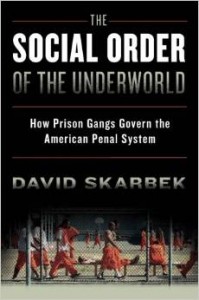 David Skarbek, Lecturer in the Department of Political Economy at King’s College in London, England and author of the book The Social Order of the Underworld: How Prison Gangs Govern the American Penal System joins Lorry to talk about prison gangs. He became interested in this topic while a California native. As an economist, Skarbek studies how individuals respond to changes in costs, benefits, and incentives. He contends that economics can provide an organizing framework for understanding prison life and its effect on society as a whole. Indeed, with the total population of US jails and prisons at 2.2 million, this is a large sector of the general population; larger than all but three US cities and greater than the population of 15 states.
David Skarbek, Lecturer in the Department of Political Economy at King’s College in London, England and author of the book The Social Order of the Underworld: How Prison Gangs Govern the American Penal System joins Lorry to talk about prison gangs. He became interested in this topic while a California native. As an economist, Skarbek studies how individuals respond to changes in costs, benefits, and incentives. He contends that economics can provide an organizing framework for understanding prison life and its effect on society as a whole. Indeed, with the total population of US jails and prisons at 2.2 million, this is a large sector of the general population; larger than all but three US cities and greater than the population of 15 states.
Although gangs might seem like a negative influence in the prison system, they actually can provide order and structure to the prison culture and likely reduce some of the brutality that might otherwise be displayed. Prison life involves rules, both formal and informal, and customs. An economic framework applied to prison culture looks at incentives and consequences of these rules and customs.
 The Convict Code
The Convict Code
Gangs have a domination over prison life in California but that was not always so. The first 100 years of prison history were managed by something called the convict code; a loose framework of rules for acceptable behavior such as never inform, never steal, don’t talk a lot, pay your debts, and do your own time. Inmate leaders would meet out justice for those who violate the code. This worked well while the prison population was small and stable.
Gangs Take Over
The inmate code structure began to unravel in the 60’s as prison growth exploded and the inmate population’s cultural background became diverse. It then became difficult for inmates to know each other and deal with reputation. As the inmate code became less effective, gangs emerged to remedy the ensuing chaos. Each gang creates their own rules of conduct and kept tabs on member reputation. Gangs often form along racial lines.
What Gangs Contribute
The popular belief that gangs are only a negative influence misses their positive impact. Here are some findings on the positive outcomes of prison gangs.
- Rules of conduct are maintained such as respect for individuals and property.
- Regulation of the membership by providing punishment for rule infraction.
- Creation of communication networks and channels inside and outside the facility.
- Regulation of the black market movement of goods and services within the inmate population.
- Conflict and violence reduction among individuals; providing protection for gang members.
Skarbeck contends that prison gangs have reduced violence and inmate death since their rise in the 70’s when rioting was more common. It is to the gang’s advantage to reduce violence and the consequences as security’s response to quell the upheaval curtails lucrative activities such as drug sales among the inmate population.
Inside Out
Prison gangs are able to maintain power while behind bars as the underworld community on the outside is aware that they are likely to be back inside at some point in their life. Recognizing this possibility, gang members are willing to take direction from prison gang leaders on the inside. So, prison gangs are able to project their power into the surrounding community. Gang activity inside and outside of prison is more cohesive than may be thought.
What has been your experience with gangs in your facility? Share your thoughts in the comments section of this post.
Leave a Reply